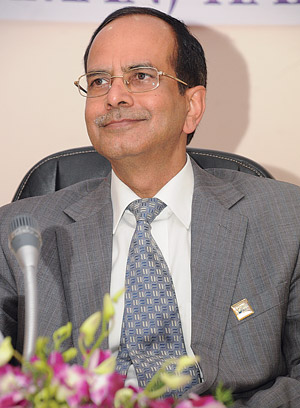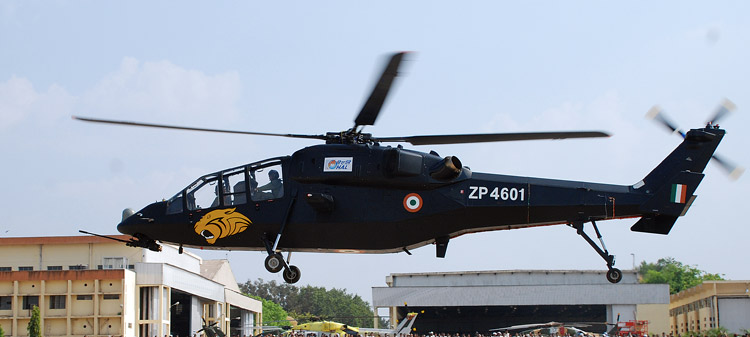- Prime Minister Narendra Modi inaugurates Aero India 2023 in Bengaluru; Releases Commemorative Stamp
- Defence Secretary meets delegations from Saudi Arabia, USA and Oman on the sidelines of Aero India 2023
- Foreign Ministers of 32 countries to attend Aero India 2023
- Embraer showcases the C-390 Millennium at Aero India 2023
'We plan to indigenise the Indian defence capabilities in a big way'
Dr R.K. Tyagi, Chairman, Hindustan Aeronautics Limited

SP’s ShowNews (SP’s): What steps is Hindustan Aeronautics Limited (HAL) taking by way of modernisation and upgradation of facilities to gear up for the fourth-generation medium multi-role combat aircraft (MMRCA) programme and other projects coming your way?
R.K. Tyagi (Tyagi): We have planned state-of-the-art manufacturing facilities for MMRCA, light utility helicopter (LUH) and medium-lift helicopter projects. Centre of Excellence in Transmission and Composites and a separate factory for manufacturing engines for helicopters exclusively are also being conceived. As I have already said, light combat aircraft (LCA) production facilities will be augmented to increase the production rate up to 16 aircraft per year. Helicopter Division facilities too will be reinforced to take up the production of light combat helicopter (LCH) in addition to the current production of advanced light helicopter (ALH).
In addition, the company is in the process of finalising the modernisation plan considering the current and new programmes, the delivery schedules and the required rate of production.The plan will provide a roadmap for creation of new facilities, induction of new technologies, augmentation/upgradation of existing facilities to cater to the design, development and manufacturing activities.
We plan to outsource in a big way and HAL has drawn up plans to outsource more than 30 per cent of the manufacturing task. This strategy would enable HAL to add and use the capacity more optimally on high value added jobs and new business opportunities.
HAL will like to enter into allied fields to widen its product/service profile. The company is pursuing strategic business alliances through partnership and joint ventures to gain access to technology and the global market. The company aims to leverage the Indian market to gain access to the global market.
SP’s: Can you give us an overview of the major projects in hand at HAL?
Tyagi: At HAL, major development projects like advanced light helicopter weaponised version, intermediate jet trainer, light combat helicopter, light utility helicopter and light combat aircraft are entering their intermediate/final phase of development. Projects like development of basic trainer aircraft, co-development projects like fifth-generation fighter aircraft (FGFA), multi-role transport aircraft (MTA) and licensed production of MMRCA, have been initiated and their preliminary activities have commenced. The immediate challenge for HAL is to put in place the right mix of resources to ensure the smooth progress of all the new and current projects and meet their time and cost milestones.
With the opening up of the defence industry to private players and the growth of the private industry in the defence sector over the past decade, HAL is moving from being a vertically integrated industry to an aircraft integrator with established supply chains rooted in the private defence industries of the country. The company has drawn up plans to outsource more than 30 per cent of the manufacturing tasks. This would enable HAL to use the capacity more optimally and focus on core competencies and high value-added jobs.

India's defence modernisation and expansion plans give "offset opportunity" for those businesses engaged in defence related activities.The projected offset opportunity market in the aerospace and defence sector in India is estimated at $30 billion (1,50,000 crore) over the next 10 years. HAL will strive to garner a major share of the offset market opportunities. If required, the company will set up a separate unit as a strategic business unit (SBU) to cater to the offset market.
We have identified unmanned aerial vehicles, civil aviation sector and development of Nasik airport for commercial operations as areas of strategic interest having immense business potential. We have arrived at this based on our market analysis reports and growth prospects. This is in addition to take advantage of offset opportunities, setting up of separate business groups we plan to establish. The market dynamics and opportunities are analysed closely to enable HAL to foray into these sectors.
SP’s: Where does the LCA Tejas stand in respect of operational clearance and induction into the IAF?
Tyagi: HAL is the major partner to the Aeronautical Development Agency (ADA) for the design and development of LCA. ADA is the designated lead designer/ project manager for the development of LCA. ADA has indicated that initial operational clearance (IOC) for the LCA is being planned to be achieved in the second quarter of 2013.
HAL is geared up to commence delivery against the current order for LCA within three to six months of the IOC certification of the aircraft. HAL has already set up the production line and has produced six limited series production aircraft pending final IOC. HAL is ready with the infrastructure to meet the immediate orders. Activities to ramp up the production from the present level to eight aircraft per year are also being taken care of. The company is planning to augment the production capacity up to 16 aircraft per year as we anticipate more orders in future.
SP’s: The IJT project had an impressive start having undertaken the first flight in record time after go-ahead sanction.What is the time frame in which the IAF should expect the aircraft to be available in sufficient numbers to take over the training role from the Kiran fleet?
Tyagi: The intermediate jet trainer (IJT) project of HAL is currently at an advanced stage of development. Flight testing has re-commenced subsequent to the design modifications from February 2012 after the loss of PT-1 aircraft. While this type of loss of aircraft needs to be avoided, such incidents of loss of prototypes have occurred in many such development programmes undertaken in other countries as well.
HAL is making all efforts to achieve the IOC at the earliest. The project is being closely monitored to ensure that any support/decisions required are given on a fasttrack mode. More than 600 flights have been completed so far. However, considering the number of test flights to be completed, the IOC is expected during the second half of 2013.





